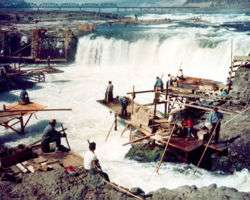Confluence Project
The Confluence Project is a series of outdoor installations and interpretive artworks located in public parks along the Columbia River and its tributaries in the U.S. states of Washington and Oregon. Each art installation explores the confluence of history, culture and ecology of the Columbia River system. The project draws on the region's history, including Native American traditional stories and entries from the Lewis and Clark Expedition journals, to "evoke a landscape and a way of life submerged in time and memory."[1] The project reaches from the mouth of the Columbia River to Hells Canyon.[2]
- See Degree Confluence Project for the quest to find the intersections of whole number latitude and longitude.
Artist and architect Maya Lin has designed installations that follow the path of Lewis and Clark through the Columbia River Basin. Lin is collaborating with landscape architects to restore natural environments, and each artwork will draw text from Lewis and Clark's journals or traditions grounded in Native American cultures. Confluence sites are meant to be places reclaimed and reimagined. The purpose is to transform our understanding we have been so that we can build a lasting stewardship into the future.
Confluence Project is a nonprofit 501(C)(3) based in Vancouver, Washington, incorporated in 2002. In addition to the public art, the organization manages two programs: Gifts from Our Ancestors brings Native artists and storytellers into schools. Confluence Friends is a program to organize volunteers at each site for maintenance and public events.
Sites
Washington
- Cape Disappointment State Park, Ilwaco, Washington[3] (Completed 2005, dedicated 2006) Map
- Ridgefield National Wildlife Refuge, Vancouver, Washington (in planning stages)
- Vancouver Land Bridge at Fort Vancouver National Historic Site, Vancouver, Washington[4] (completed 2008)
- Sacajawea State Park, Pasco, Washington[5] (Completed 2010)
- Chief Timothy Park, Clarkston, Washington[6] (Scheduled for completion in Spring 2015)
Oregon
- Sandy River Delta Bird Blind[7] (Completed 2008)
- Celilo Falls (Scheduled for completion in 2016)[8]
References
- Raymond, Camela (November 2007). "The Shape of Memory". Portland Monthly.
- "Archived copy". Archived from the original on 2014-11-24. Retrieved 2014-11-14.CS1 maint: archived copy as title (link)
- "Cape Disappointment State Park". Archived from the original on 2010-12-06. Retrieved 2010-12-09.
- Fort Vancouver National Historic Site (U.S. National Park Service)
- Sacajawea State Park Archived 2006-09-07 at the Wayback Machine
- Confluence Project: project sites
- Confluence Project: project sites: Sandy River Delta
- Fogarty, Colin (March 14, 2014). "Art Installation Will Recall Silenced Celilo Falls". The Oregonian. Retrieved 2014-03-14.
External links
- Confluence Project
- "A Meeting Of Minds". The Seattle Times. 2005-06-12. Archived from the original on 2006-05-07. Retrieved 2006-09-07.
- "Maya Lin advances Confluence Project". The Oregonian. 2004-04-01. Retrieved 2006-09-07.
